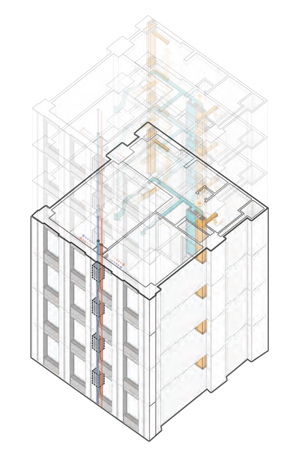
Passivhaus diagram for a multifamily residential building.
When: Sunday, 29 October 2017, Morning
Venue: The University of New South Wales
Kindly Hosted by:
|
Supported by:
|
The Passivhaus standard rigorously stipulates whole-building energy performance that exceeds most other standards and requires planning from the outset of design. It was less than four years ago that the Passivhaus Institute recognized the world’s first skyscraper built to the Passivhaus standard, the Raiffeisen-Holding Hochhaus in Vienna. Since that time, a flurry of activity has emerged around the world, with dozens of projects now completed or underway.

Dr. Phil Oldfield, University of New South Wales, will lead the workshop.
On the morning of Sunday, 29 October 2017, in Sydney, the day before the CTBUH 2017 Australia Conference, CTBUH is convening a half-day workshop to establish the most salient issues, challenges and techniques for achieving Passivhaus high-rise buildings economically, with an ultimate goal of forming an international committee and developing a CTBUH Technical Guide on Passivhaus High-Rise Construction.
The workshop will be led by Dr. Phil Oldfield, Senior Lecturer at the School of Architecture and Design, Department of Built Environment, University of New South Wales, Sydney. Oldfield is the author of the upcoming book The Sustainable Tall Building: A Design Primer, and has been active in numerous roles with CTBUH, including the 2017 Conference Steering Committee, the Urban Habitat / Urban Design Committee, and the Expert Peer Review Committee.
Participants in the workshop are likely to include representatives of the following projects and organizations, and more:
- Atelier Hayde Architekten – Raiffeisen-Holding Hochhaus, Vienna
- Ateliers Jean Nouvel – Police Headquarters & Charleroi Danses, Charleroi, Belgium
- CREE – Life Cycle Tower One – Dornbirn, Austria
- FXFOWLE – Feasibility Study to Implement the Passivhaus Standard on Tall Residential Buildings, New York
- Handel Architects – Cornell Tech Residential Tower, New York
- Kaufmann Partner Architekten – Power Tower, Linz, Austria
- Peter Ruge Architekten – Passive House Bruck, Huzhou, China
- Pitt & Sherry – Accelerating Net Zero Residential Buildings, Sydney
- VARQUITECTOS – VPO en Bolueta, Bilbao, Spain
To learn more about other workshops, click here.


